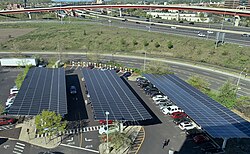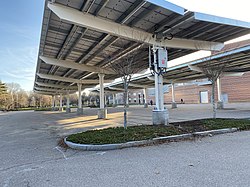Earth:Solar canopy



Solar canopies are solar arrays installed on canopies, which could be a parking lot canopy, carport, gazebo, Pergola, or patio cover.
Solar canopy parking lots

The mounting structure makes solar canopy parking lots 50% to twice as expensive to build as traditional grass field solar arrays, but as distributed energy resources they avoid transmission congestion and losses.[1] The canopies can protect the cars and asphalt from extreme weather.
A French law passed in 2023 will require parking lots larger than 50,000 square feet (4,600 m2) to build solar canopies covering half their area. This could result in installed capacity of 6.75–11.25 gigawatts, at a cost of $8.7–14.6 billion.[2]
In 2022, the world's largest solar car park canopy opened in the Netherlands with 35 MW capacity.[3]
Rutgers University is building 14.5 MW of solar canopies on parking lots in 2023, which will generate 18 GWh annually, in addition to the 32-acre 8.8 MW solar canopy parking lot already installed there in 2013.[4]
If Walmart Supercenters installed Solar canopies on their 3,500+ parking lots it would generate 11.1 gigawatts of solar power nameplate capacity.[5][6]
Gazebos
At parks or backyard patios, gazebos can be installed as a solar canopy.[7]

Tesla Supercharger stations with solar canopies
Some Tesla Supercharger stations have solar canopies installed to protect drivers and vehicles from the elements while recharging. Tesla Megapacks are also installed at some of these locations to store that energy locally.[8]

See also
- Community solar
- Solar landfill
References
- ↑ "Archived copy". https://www.youtube.com/watch?v=yeaQUhAOdtk.
- ↑ Birnbaum, Michael (2023-02-08). "New French law will blanket parking lots with solar panels" (in en-US). Washington Post. ISSN 0190-8286. https://www.washingtonpost.com/climate-solutions/2023/02/06/france-solar-parking-lots/.
- ↑ "Largest solar car park in the world opens at Dutch music festival" (in en). 2022-05-11. https://www.euronews.com/green/2022/05/11/largest-solar-car-park-in-the-world-opens-at-famous-dutch-festival.
- ↑ Lewis, Michelle (2023-06-21). "Rutgers University is still a trailblazer in parking lot solar" (in en-US). https://electrek.co/2023/06/21/rutgers-university-parking-lot-solar/.
- ↑ "Why Putting Solar Canopies on Parking Lots Is a Smart Green Move" (in en-US). https://e360.yale.edu/features/putting-solar-panels-atop-parking-lots-a-green-energy-solution.
- ↑ Deshmukh, Swaraj Sanjay; Pearce, Joshua M. (2021-05-01). "Electric vehicle charging potential from retail parking lot solar photovoltaic awnings". Renewable Energy 169: 608–617. doi:10.1016/j.renene.2021.01.068. ISSN 0960-1481. https://research.aalto.fi/files/55239913/ELEC_Pearce_Electric_vehicle_charging_potential.pdf.
- ↑ "Are solar canopies and carports worth it?" (in en). 2023-11-14. https://www.solarreviews.com/content/blog/are-solar-canopies-worth-it.
- ↑ https://www.tesmanian.com/blogs/tesmanian-blog/first-known-tesla-v4-supercharger-with-solar-panels-and-megapack-is-coming-to-arizona
 |

